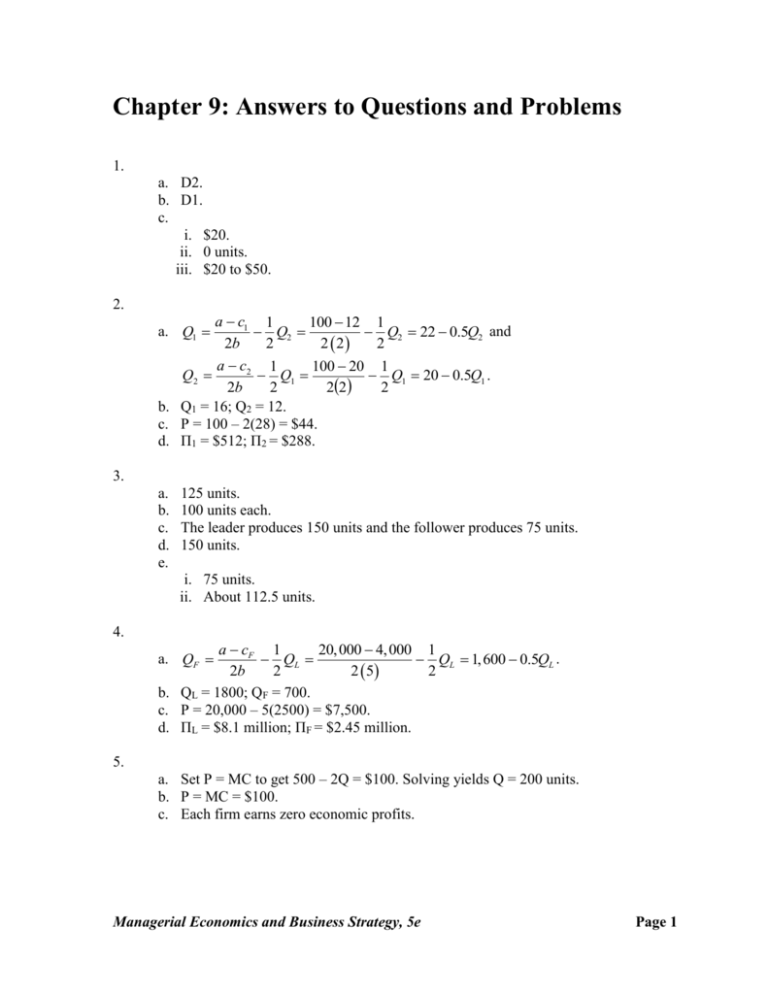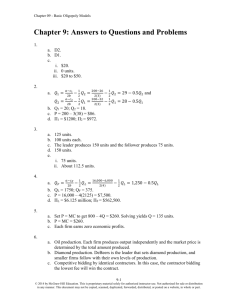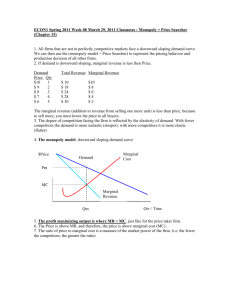Chapter 9: Answers to Questions and Problems
advertisement

Chapter 9: Answers to Questions and Problems 1. a. D2. b. D1. c. i. $20. ii. 0 units. iii. $20 to $50. 2. a c1 1 100 12 1 Q2 Q2 22 0.5Q2 and 2b 2 2 2 2 a c2 1 100 20 1 Q2 Q1 Q1 20 0.5Q1 . 2b 2 22 2 b. Q1 = 16; Q2 = 12. c. P = 100 – 2(28) = $44. d. Π1 = $512; Π2 = $288. a. Q1 3. a. b. c. d. e. 125 units. 100 units each. The leader produces 150 units and the follower produces 75 units. 150 units. i. 75 units. ii. About 112.5 units. 4. a cF 1 20, 000 4, 000 1 QL QL 1, 600 0.5QL . 2b 2 2 5 2 b. QL = 1800; QF = 700. c. P = 20,000 – 5(2500) = $7,500. d. ΠL = $8.1 million; ΠF = $2.45 million. a. QF 5. a. Set P = MC to get 500 – 2Q = $100. Solving yields Q = 200 units. b. P = MC = $100. c. Each firm earns zero economic profits. Managerial Economics and Business Strategy, 5e Page 1 6. a. Oil production. Each firm produces output independently and the market price is determined by the total amount produced. b. Diamond production. DeBeers is the leader that sets diamond production, and smaller firms follow with their own levels of production. c. Competitive bidding by identical contractors. In this case, the contractor bidding the lowest fee will win the contract. 7. Model Cournot Stackelberg Bertrand Collusion Output Q1 = Q2 = 58.30 QL = 87.5; QF = 43.75 Market output = 175 units Market output = 87.5 units Profits π1 = π2 = $6,805.56 πL = $7,656.25; πF = $3,828.13 Zero Industry Profits = $15,312.50 8. a. Firm 1’s output and profit would increase. Firm 2’s output and profits would decrease. b. For small changes in costs, there would be no change in output or profits. 9. This would positively impact sales and the firm’s bottom line if Ford is the only company to offer such a program. However, one would expect rivals (such as GM) to respond by with a similar plan. This would reduce the impact of Ford’s program on your sales and bottom line. Indeed, GM did quickly respond with its Drive America program. 10. Since this is a homogeneous product Cournot oligopoly, BlackSpot’s initial equilibrium output can readily be computed to be 2900 units. Since the corresponding market price is $2,200.00 and BlackSpot’s marginal cost is $750, it follows that its profit gross of fixed costs is (P – MC)Qi = ($2200 - $750)(2900) = $4,205,000. (Since profits net of fixed costs are only $1 million, it follows that BlackSpot’s fixed costs are $3.205 million). When marginal cost for BlackSpot falls to $500 (but Condensed Computers’ marginal cost remains at $750), BlackSpot’s equilibrium output increases to 3233.3 units and the market price falls to $2,116.67. BlackSpot’s profit increases by $1,022,222.22. 11. In this homogeneous product Bertrand oligopoly, the equilibrium price equals marginal cost of $1.25. The total market quantity sold is Q = 50 – 10(1.25) = 37.5 units. If one station is self-serve while the other is full-service, the differentiated nature of the products may permit each firm to charge a price above $1.25. This will result in fewer units of gasoline being sold, but the firms will enjoy higher profits. 12. No. A quota may actually increase the profits of the follower. 13. OPEC must reduce its output when rivals (such as Russia, Omar, Mexico, Norway, and other non-OPEC countries) increase their output. This reduction in output lowers their profits, making it difficult to accomplish. Page 2 Michael R. Baye 14. No. The industry is contestable. 15. You should support the legislation. Absent the legislation, this homogeneous product Bertrand oligopoly will result in marginal cost pricing and zero profits. Under the legislation, you will earn a profit of $60 - $50 = $10 on each unit sold. Your 20 percent of the contract amounts to 54 units, so your total profits under the congresswoman’s plan is $540 compared to the $0 you will earn under cutthroat Bertrand competition. 16. Yes, it would be profitable to merge. Your current Stackelberg profits are $20,000 and your rival’s are $6,400. If you merge, you would not face any competition. In addition, would be able to produce all output at your own facilities (which have lower costs). Your post-merger monopoly profits would be based on your monopoly output, which occurs where MR = MC: 800 – 8Q = 40, or Q = 95 units. The monopoly price is $420. Your monopoly profits are ($420 - $40)(95) = $36,100, so you stand to gain $16,100 by merging. If you offer your rival $6,400.01 to merge, it is strictly better off and so are you. 17. Under the status-quo of Cournot oligopoly, your equilibrium profits are $256. If costs were the same but you were the leader in a Stackelberg oligopoly, your equilibrium profits would be $288. Since this difference is only $32, it would not pay to spend $40 on the investment: The cost of establishing the first-mover advantage exceeds the benefits. 18. When Ajinomoto was the sole supplier of lysine, it charged the monopoly price of $1.65 per pound and sold 76 million pounds; found by solving MR = MC. The dramatic price decline (to marginal cost) in the worldwide market for lysine after ADM entered the market can be explained by Bertrand competition: the two firms compete by setting price in the worldwide market driving price to marginal cost. At this price, 152 million pounds were sold in the worldwide market and each firm sold 76 million pounds (by assumption). The 1993 price increase can be explained by collusion: ADM and Ajinomoto set the monopoly price and produce an equal share of the monopoly output. Therefore, price rose to $1.65 per pound and 76 million pounds are sold on the worldwide market; with each firm supplying 38 million pounds of lysine. 19. The inverse demand function for this Sweezy oligopoly 800 0.5Q if Q 300 is P . The marginal revenue function 1250 2Q if Q 300 800 Q if Q 300 is MR 50, 500 if Q 300 . Therefore, changes in marginal cost in the range of 1250 4Q if Q 300 $50 and $500 will not result in a change in the profit-maximizing level of output. Managerial Economics and Business Strategy, 5e Page 3







